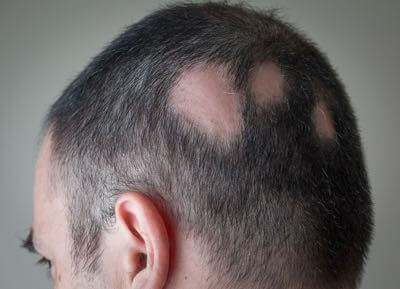Alopecia Areata Study in San Diego
JOIN AN ALOPECIA AREATA STUDY
Like it or not, our hair is a big part of our identity. That is why men fret when male pattern balding begins to rear its ugly head and why people spend so much time at salons and on hair products. It is an essential part of the way we look, and to lose hair can drastically change the way people look and feel. That is why alopecia areata is such a concern, even though it creates little actually change people's physical health. Lucky for those suffering from alopecia areata, California Dermatology and Clinical Research Institute in Encinitas offers clinical research studies that provide free investigational medications for alopecia areata.
What is Alopecia Areata?
Alopecia areata is a specific type of hair loss caused by an overactive immune system. This occurs when the bodies immune system attacks your hair follicles. The hair follicles are the root of all hair growth, so when the immune system mistakenly hinders the hair follicles, hair growth abruptly stops. This damage to the hair follicles caused by alopecia areata is in most cases not permanent, but can cause a large amount of temporary hair loss. Scientists struggle to pin down why the immune system attacks the hair follicles, but research such as that done by California Dermatology and Clinical Research Institute in Encinitas may one day be able to figure this disease out. Alopecia Areata most commonly begins during the teen years and younger, with most people initially afflicted under the age of 20, but people of any age are susceptible and the disease can wax and wane for many years after first appearing.
What are the Symptoms of Alopecia Areata?
Alopecia areata will first show itself when small bald areas starts to appear. As the hair falls out the skin will be completely smooth and hairless, creating small spots of scalp showing around healthy hair. In a few cases the hair may only become thin and not actually fall out or continue to grow and eventually break off. When the hair breaks off it will leave tiny stubbles of hair on the head. In some extreme cases of alopecia areata, the person will lose all hair on the head and the body, but this is a relatively rare occurrence. The loss of hair is sporadic, occurring in one area of the head for a few months and then a different area after that, with the hair usually growing back in a few months. About 10% of the people afflicted may never grow back the hair they have lost. As of right now, there is not FDA-approved therapy for alopecia areata but clinical trials are trying to change that.
Are Those With Alopecia Areata at Risk of Never Growing Back Their Hair?
As stated above, only about 10% of people with alopecia areata never grow their hair back. So that raises the question, what makes people at risk to never grow their hair back after losing it because of alopecia areata? Here are a few precursors for people who may not be able to grow back their hair.
Currently have an additional autoimmune disease
Suffer from drastic hair loss
First started losing hair before puberty
Have been losing hair from alopecia areata for over 1 year.
Have allergies
Have a family history of alopecia areata
Have abnormal fingernails or toenails, specifically in regards to the shape, color, thickness or texture of the nail
How is Alopecia Areata Diagnosed?
If you are experiencing symptoms of alopecia areata, go visit a doctor or medical professional immediately. The doctor will look through your medical history, give you a physical examination, and ask you a series of questions about your hair. They may even grab hair and tug gently on it to see how easily it will come out. If the doctor does not have a firm grasp on whether or not you have alopecia areata at this point, they will run a few tests, such as a hair analysis or blood test, to determine the reason you are losing hair.
How is Alopecia Areata Treated?
Since alopecia areata is usually temporary and all of the symptoms are aesthetic, with little-to-no physical pain, many decide to leave alopecia areata untreated. If you do seek treatment to replace the hair that is lost from alopecia areata, there are a few different treatments available.
A common treatment for hair loss is corticosteroid injections directly into the scalp or skin every 4 to 6 weeks. Some other treatments include topical corticosteroids, Rogaine, and anthralin. All treatments merely seek to grow hair back, they do not do anything to stop or treat alopecia areata. To date, there are no officially FDA-approved treatments for alopecia aerate. The treatments discussed above are all used “off-label" by doctors. Off-Label use is perfectly acceptable but points to the need for more effective, better studied treatments for alopecia aerate.
Alopecia Areata Treatment with Research Trials
If you suffer from alopecia areata in San Diego, California Dermatology and Clinical Research Institute may be able to help. At our Encinitas location we are familiar with all of the currently used treatments and often have clinical research studies to help find safe and effective treatments that are so badly needed for alopecia areata. If you have alopecia areata, contact California Dermatology and Clinical Research Institute today to see if there is a current study enrolling. Give us a call at (760) 203-3839.





